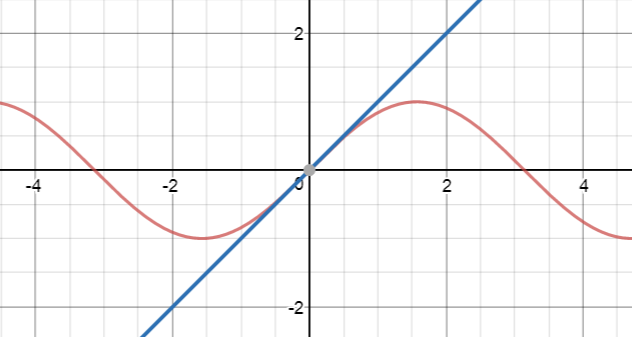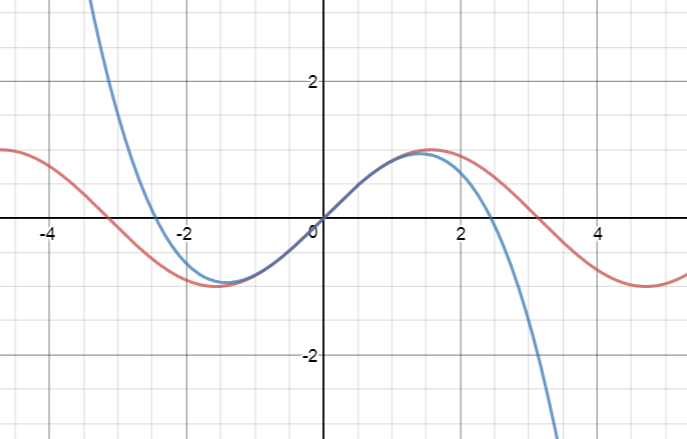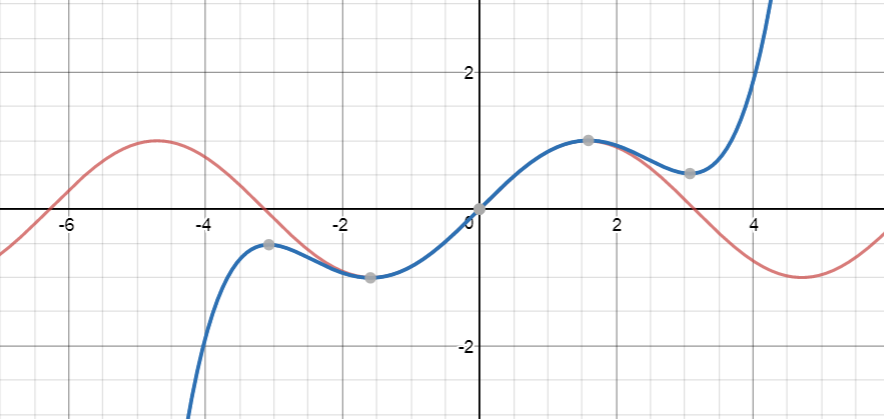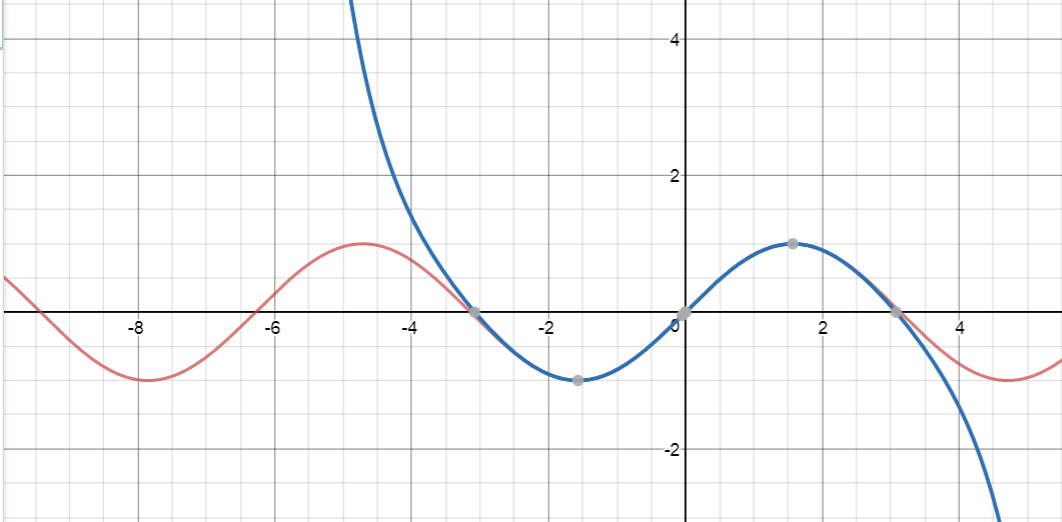Calculus
Chapters
Using Taylor Series to Approximate Functions
Using Taylor Series to Approximate Functions
Sam is conducting an experiment. He's interested in the rate of decay of a banana that he left in his lunch box at the end of last term. He decides to use the exponential decay function
Luckily, we can approximate functions like \(e^x\) using Taylor series. Taylor series can be thought of as polynomials with an infinite number
of terms. To approximate function values, we just evaluate the sum of the first few terms of the Taylor series. For nicely behaved functions,
taking more terms of the Taylor series will give a better approximation.
Example:
The Taylor series of \(y = e^x\) is
Let's try some approximations of \(e^x\) at \(x = 1\) using this Taylor series. We should expect that the values will eventually match up with \(e = 2.71828\dots\).
| Number of Terms | Part of Taylor Series | Value at \(x=1\) |
| 1 | 1 | 1 |
| 2 | \(1 + x\) | 2 |
| 3 | \(1 + x + \dfrac{x^2}{2!}\) | 2.5 |
| 4 | \(1 + x + \dfrac{x^2}{2!} + \dfrac{x^3}{3!}\) | 2.66667 |
| 5 | \(1 + x + \dfrac{x^2}{2!} + \dfrac{x^3}{3!} + \dfrac{x^4}{4!}\) | 2.70833 |
You can see that the approximations are getting closer and closer to \(e = 2.71828\dots\).
Commonly Used Taylor Series
Functions like \(\sin x\) and \(\cos x\) are commonly used in signal processing, so it's important to be able to approximate them. Here is a list of a few commonly used functions, and their Taylor series.
| Function | Taylor Series | Taylor Series in Summation Notation |
| \(e^x\) | \(1 + x + \dfrac{x^2}{2!} + \dfrac{x^3}{3!} + \dots \) | \(\displaystyle{\sum_{n = 0}^{\infty} \frac{x^n}{n!}}\) |
| \(e^{-x}\) | \(1 - x + \dfrac{x^2}{2!} - \dfrac{x^3}{3!} + \dots \) | \(\displaystyle{\sum_{n = 0}^{\infty}\frac{(-1)^n }{n!}\;x^n}\) |
| \(\sin x\) | \(x - \dfrac{x^3}{3!} + \dfrac{x^5}{5!} - \dots \) | \(\displaystyle{\sum_{n = 0}^{\infty}\frac{(-1)^n }{(2n + 1)!}\;x^{2n + 1}}\) |
| \(\cos x\) | \(1 - \dfrac{x^2}{2!} + \dfrac{x^4}{4!} - \dots \) | \(\displaystyle{\sum_{n = 0}^{\infty}\frac{(-1)^n }{(2n)!}\;x^{2n}}\) |
| \(\dfrac{1}{1 - x}\) for \(|x| | \(1 + x + x^2 + x^3 + \dots\) | \(\displaystyle{\sum_{n = 0}^\infty x^n}\) |
Of course, these are only a few of the many possible Taylor series that can be used to approximate functions.
Looking at the Approximations Graphically
As I said earlier, you can use the first few terms of the Taylor Series of a function to approximate it. If you take more terms, and the function behaves properly, you get a better approximation.
Let's see this in action on the graph of \(y = \sin x\). At each step, the red graph is the graph of \(\sin x\) and the blue graph is the graph of the Taylor Series approximation.




How do we find these polynomials?
This idea was thought up by some very clever people: a Scottish mathematician, James Gregory, and an English mathematician, Brook Taylor, back in the 18th Century. There's nothing very mysterious about finding Taylor series, just a number of steps to follow:
- Decide you'd like to find a series to approximate your function: \(f(a) = c_0 + c_1(x - a) + c_2 (x - a)^2 + \dots\).
- Choose a value of \(a\).
- Use derivatives to work out the values of \(c_0,c_1,c_2,\dots\).
To find \(c_0\), set \(x = a\). Then our infinite series approximation collapses to
Now, we need to find \(c_1\). We take the derivative of both sides of our infinite series approximation:
To find \(c_2\), we need to take the derivative again:
We should start to see a pattern now. The coefficient \(c_n\) is found by
- taking the \(n\)th derivative \(f^{(n)}(a)\) and
- dividing it by the product of the powers of all the preceding terms (i.e. \(n! = n \times (n-1) \times \dots \times 2\times 1\)).
Example: The Taylor Series for \(\sin(x)\)
Let's start with
- \(f'(x) = \cos x\)
- \(f''(x) = -\sin x\)
- \(f'''(x) = - \cos x \)
- \(f^{(iv)}(x) = \sin x\)
So, our series looks like:
Do you notice how all the terms with even powers of \(x\) have vanished? This is good because \(\sin (x) \) is an odd function, so we'd expect its polynomial approximations to include only odd powers of \(x\). Take a look at the article on odd and even functions if you feel like you need a refresher on these important types of functions.
Stuff for you to do:
Why not have a go at finding the Taylor Series of \(\cos x\) and \(e^x\)? It will help you to fix these ideas in your head.
Historical Note:
Taylor Series with \(a = 0\) are often called Maclaurin Series after the Scottish mathematician, Colin
Maclaurin who did a great deal of work with them in the 18th Century.
Oh, and what about Sam? He can use a few terms of the Taylor Series for \(e^{-x}\) and multiply them by 2. He can then plug in \(x = \dfrac{d}{2}\) to approximate the amount of his banana that's left on day \(d\). However, both his mum and I agree that it's better to eat the banana in the first place or, at the very least, to throw it out as soon as it goes mouldy.
Description
Calculus is the branch of mathematics that deals with the finding and properties of derivatives and integrals of functions, by methods originally based on the summation of infinitesimal differences. The two main types are differential calculus and integral calculus.
Environment
It is considered a good practice to take notes and revise what you learnt and practice it.
Audience
Grade 9+ Students
Learning Objectives
Familiarize yourself with Calculus topics such as Limits, Functions, Differentiability etc
Author: Subject Coach
Added on: 23rd Nov 2017
You must be logged in as Student to ask a Question.
None just yet!